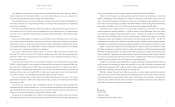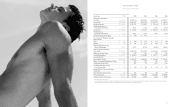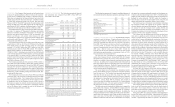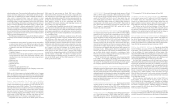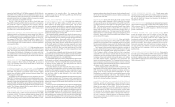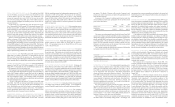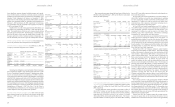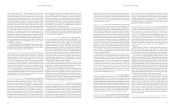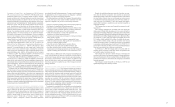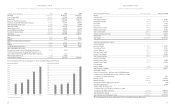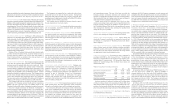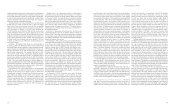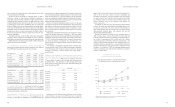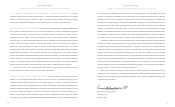Abercrombie & Fitch 2006 Annual Report Download - page 12
Download and view the complete annual report
Please find page 12 of the 2006 Abercrombie & Fitch annual report below. You can navigate through the pages in the report by either clicking on the pages listed below, or by using the keyword search tool below to find specific information within the annual report.
the outcome of various issues. Management may also use outside
legal advice to assist in the estimating process. However, the ultimate
outcome of various legal issues could be different than management
estimates, and adjustments may be required. The Company accrues
for its legal obligations for outstanding bills, expected defense costs and,
if appropriate, settlements. Accruals are made for personnel, general
litigation and intellectual property cases.
EQUITY COMPENSATION EXPENSE Prior to January 29,
2006, the Company reported share-based compensation through the
disclosure-only requirements of SFAS No. 123, “Accounting for Stock-
Based Compensation,” as amended by SFAS No. 148, “Accounting for
Stock-Based Compensation–Transition and Disclosure–an Amendment
of FASB No. 123,” but elected to measure compensation expense using
the intrinsic value method in accordance with APB Opinion No. 25,
“Accounting for Stock Issued to Employees,” for which no expense was
recognized for stock options if the exercise price was equal to the market
value of the underlying Common Stock on the date of grant, and
provided the required pro forma disclosures in accordance with SFAS
No. 123, “Accounting for Stock-Based Compensation”(“SFAS No. 123”),
as amended.
Effective January 29, 2006, the Company adopted the provisions of
SFAS No.123(R) which requires stock options to be accounted for
under the fair value method and requires the use of an option-pricing
model for estimating fair value. Accordingly, share-based compensa-
tion is measured at the grant date, based on the fair value of the award.
The Company’s equity compensation expense related to stock
options is estimated using the Black-Scholes option-pricing model to
determine the fair value of the stock option grants, which requires the
Company to estimate the expected term of the stock option grants and
expected future stock price volatility over the term. The term repre-
sents the expected period of time the Company believes the options will
be outstanding based on historical information. Estimates of expected
future stock price volatility are based on the historic volatility of the
Company’s stock for the period equal to the expected term of the stock
option. The Company calculates the historic volatility as the annu-
alized standard deviation of the differences in the natural logarithms
of the weekly stock closing price, adjusted for stock splits.
The fair value calculation under the Black-Scholes valuation
model is particularly sensitive to changes in the term and volatility
assumptions. Increases in term or volatility will result in a higher fair
valuation of stock option grants. Assuming all other assumptions dis-
closed in Note 4 of the Notes to the Consolidated Financial
Statements, “Share Based Compensation,” being equal, a 10% increase
in term will yield a 5% increase in the Black-Scholes valuation, while
a 10% increase in volatility will yield a 7% increase in the Black-
Scholes valuation. The Company believes that changes in term and
volatility would not have a material effect on the Company’s results
since the number of stock options granted during the periods pre-
sented was not material.
RECENTLY ISSUED ACCOUNTING PRONOUNCEMENTS
In July 2006, the FASB released Interpretation No. 48, “Accounting for
capitalized. Long-lived assets are reviewed at the store level period-
ically for impairment or whenever events or changes in circumstances
indicate that full recoverability of net assets through future cash flows
is in question. Factors used in the evaluation include, but are not lim-
ited to, management’s plans for future operations, recent operating
results and projected cash flow.
INCOME TAXES Income taxes are calculated in accordance with
SFAS No. 109, “Accounting for Income Taxes,” which requires the use
of the asset and liability method. Deferred tax assets and liabilities are
recognized based on the difference between the financial statement car-
rying amounts of existing assets and liabilities and their respective
tax bases. Deferred tax assets and liabilities are measured using cur-
rent enacted tax rates in effect for the years in which those temporary
differences are expected to reverse. Inherent in the measurement of
deferred balances are certain judgments and interpretations of enacted
tax law and published guidance with respect to applicability to the
Company’s operations. A valuation allowance has been provided for
losses related to the start-up costs associated with operations in foreign
countries. No other valuation allowances have been provided for
deferred tax assets because management believes that it is more likely
than not that the full amount of the net deferred tax assets will be real-
ized in the future. The effective tax rate utilized by the Company
reflects management’s judgment of the expected tax liabilities within
the various taxing jurisdictions.
The provision for income taxes is based on the current estimate of
the annual effective tax rate adjusted to reflect the tax impact of items
discrete to the quarter. The Company records tax expense or benefit
that does not relate to ordinary income in the current fiscal year dis-
cretely in the period in which it occurs pursuant to the requirements
of APB Opinion No. 28, “Interim Financial Reporting” and Financial
Accounting Standards Board issued Interpretation (“FIN”) 18,
“Accounting for Income Taxes in Interim Periods – an Interpretation of APB
Opinion No. 28.” Examples of such types of discrete items include, but
are not limited to, changes in estimates of the outcome of tax matters
related to prior years, provision-to-return adjustments, tax-exempt
income and the settlement of tax audits.
FOREIGN CURRENCY TRANSLATION Some of the Company’s
international operations use local currencies as the functional currency.
In accordance with SFAS No. 52, “Foreign Currency Translation”, assets and
liabilities denominated in foreign currencies were translated into U.S. dol-
lars (the reporting currency) at the exchange rate prevailing at the balance
sheet date. Revenues and expenses denominated in foreign currencies were
translated into U.S. dollars at the monthly average exchange rate for the
period. Gains and losses resulting from foreign currency transactions are
included in the results of operations, whereas related translation adjust-
ments are reported as an element of other comprehensive income in
accordance with SFAS No. 130, “Reporting Comprehensive Income.”
CONTINGENCIES In the normal course of business, the Company
must make continuing estimates of potential future legal obligations
and liabilities, which requires the use of management’s judgment on
Abercrombie &Fitch
23
Abercrombie &Fitch
$130 to approximately $147. The Company expects the average
construction cost per square foot, net of construction allowances,
for new abercrombie stores to decrease from last year’s actual cost of
approximately $169 to approximately $164. The change from last
year’s estimates for Hollister and abercrombie were driven by a number
of factors, including store location, construction material pricing,
landlord allowance levels, and furniture and fixture additions. During
Fiscal 2007, the Company expects average construction cost per square
foot, net of construction allowances, for new non-flagship Abercrombie
& Fitch stores to be approximately $115 and for new RUEHL stores
to be approximately $274 per square foot, net of construction
allowances. The Company believes that the construction costs for
Abercrombie & Fitch and RUEHL stores in Fiscal 2006 were not
representative of the costs the Company expects to incur in Fiscal 2007
and therefore comparisons with these numbers would not be mean-
ingful. The Company expects initial inventory purchases for the stores
to average approximately $0.4 million, $0.2 million, $0.3 million and
$0.5 million per store for Abercrombie & Fitch, abercrombie, Hollister
and RUEHL, respectively.
The Company expects that substantially all future capital expendi-
tures will be funded with cash from operations. In addition, the Company
has $250 million available (less outstanding letters of credit) under its
Amended Credit Agreement to support operations.
CRITICAL ACCOUNTING POLICIES AND ESTIMATES
The Company’s discussion and analysis of its financial condition and
results of operations are based upon the Company’s consolidated
financial statements, which have been prepared in accordance with
accounting principles generally accepted in the United States
(“GAAP”). The preparation of these financial statements requires
the Company to make estimates and assumptions that affect the
reported amounts of assets, liabilities, revenues and expenses. Since
actual results may differ from those estimates, the Company revises its
estimates and assumptions as new information becomes available.
The Company’s significant accounting policies can be found in the
Notes to Consolidated Financial Statements (see Note 2 of the Notes
to Consolidated Financial Statements). The Company believes that the
following policies are most critical to the portrayal of the Company’s
financial condition and results of operations.
REVENUE RECOGNITION The Company recognizes retail sales
at the time the customer takes possession of the merchandise and
purchases are paid for, primarily with either cash or credit card.
Direct-to-consumer sales are recorded upon customer receipt of
merchandise. Amounts relating to shipping and handling billed to
customers in a sale transaction are classified as revenue and the related
direct shipping and handling costs are classified as stores and distri-
bution expense. Associate discounts are classified as a reduction of
revenue. The Company reserves for sales returns through estimates
based on historical experience and various other assumptions that
management believes to be reasonable. The Company’s gift cards do
not expire or lose value over periods of inactivity. The Company
accounts for gift cards by recognizing a liability at the time a gift card
is sold. The liability remains on the Company’s books until the ear-
lier of redemption (recognized as revenue) or when the Company
determines the likelihood of redemption is remote (recognized as
other operating income). The Company determines the probability of
the gift card being redeemed to be remote based on historical redemp-
tion patterns and at these times recognizes the remaining balance as
other operating income. At February 3, 2007 and January 28, 2006, the
gift card liability on the Company’s Consolidated Balance Sheet was
$65.0 million and $53.2 million, respectively.
The Company is not required by law to escheat the value of unre-
deemed gift cards to the states in which it operates. During Fiscal 2006,
Fiscal 2005 and Fiscal 2004, the Company recognized other operating
income for adjustments to the gift card liability of $5.2 million, $2.4 mil-
lion and $4.3 million, respectively.
INVENTORY VALUATION Inventories are principally valued at
the lower of average cost or market utilizing the retail method. The
Company determines market value as the anticipated future selling
price of the merchandise less a normal margin. An initial markup is
applied to inventory at cost in order to establish a cost-to-retail ratio.
Permanent markdowns, when taken, reduce both the retail and cost
components of inventory on hand so as to maintain the already estab-
lished cost-to-retail relationship. At first and third fiscal quarter end,
the Company reduces inventory value by recording a markdown
reserve that represents the estimated future anticipated selling price
decreases necessary to sell-through the current season inventory. At
second and fourth fiscal quarter end, the Company reduces inventory
value by recording a markdown reserve that represents the estimated
future selling price decreases necessary to sell-through any remaining
carryover inventory from the season just passed.
Additionally, as part of inventory valuation, an inventory shrink
estimate is made each period that reduces the value of inventory for lost
or stolen items. The Company performs physical inventories through-
out the year and adjusts the shrink reserve accordingly.
Inherent in the retail method calculation are certain significant
judgments and estimates including, among others, markdowns and
shrinkage, which could significantly impact the ending inventory
valuation at cost as well as the resulting gross margins. An increase or
decrease in the inventory shrink estimate of 10% would not have a
material impact on the Company’s results of operations. Management
believes this inventory valuation method is appropriate since it pre-
serves the cost-to-retail relationship in ending inventory.
PROPERTY AND EQUIPMENT Depreciation and amortiza-
tion of property and equipment are computed for financial reporting
purposes on a straight-line basis, using service lives ranging principally
from 30 years for buildings, the lesser of ten years or the life of the lease
for leasehold improvements and three to ten years for other property
and equipment. The cost of assets sold or retired and the related
accumulated depreciation or amortization are removed from the
accounts with any resulting gain or loss included in net income.
Maintenance and repairs are charged to expense as incurred. Major
remodels and improvements that extend service lives of the assets are
22




